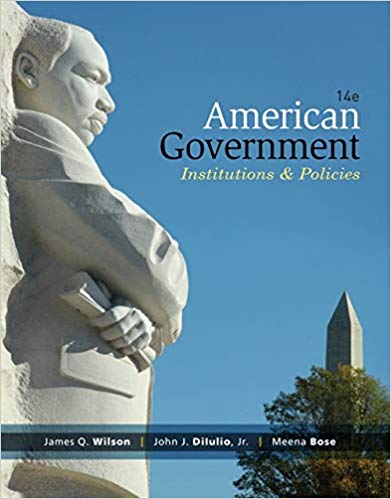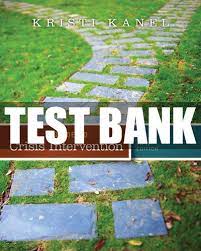Description
Test Bank For American Government Institutions & Policies 14th Edition by James Q. Wilson
CHAPTER 3
Federalism
MULTIPLE CHOICE
1.When the Framers drafted the Constitution, the Antifederalist opposed it primarily on the grounds that the new government
|
a. |
empowered state governments. |
|
b. |
created a bicameral Congress. |
|
c. |
gave states the power to coin money. |
|
d. |
created a navy. |
|
e. |
gave too much power to the national government. |
ANS: E REF: 51 NOT: F OBJ: LO1
2.In this decision, the Supreme Court, by a 5–4 majority, ruled that the individual mandate component of Obamacare was constitutional because the mandate was a tax and was one of the powers of Congress.
|
a. |
Baker v. Carr |
|
b. |
U.S. v. Lopez |
|
c. |
Printz v. U.S. |
|
d. |
McCulloch v. Maryland |
|
e. |
National Federation of Business v. Sebelius |
ANS: E REF: 51 NOT: F OBJ: LO1
3.__________ is a political system in which the national government shares power with local governments.
|
a. |
A unitary government |
|
b. |
Federalism |
|
c. |
A confederation |
|
d. |
A parliamentarian government |
|
e. |
A republic |
ANS: B REF: 51 NOT: F OBJ: LO1
4.For the Founders, federalism was a device to
|
a. |
protect personal liberty. |
|
b. |
provide efficient local administration. |
|
c. |
encourage citizen participation. |
|
d. |
guarantee equality. |
|
e. |
protect against foreign invasion. |
ANS: A REF: 53 NOT: F OBJ: LO1
5.In a confederation, the national government derives its power from
|
a. |
the people. |
|
b. |
the states. |
|
c. |
the Congress. |
|
d. |
the courts. |
|
e. |
None of the above is true. |
ANS: B REF: 53 NOT: F OBJ: LO1
6. A federal republic derives its powers from
|
a. |
the people. |
|
b. |
the states. |
|
c. |
the Congress. |
|
d. |
the courts. |
|
e. |
None of the above is true. |
ANS: A REF: 53 NOT: F OBJ: LO1
7.Madison’s description of federalism in Federalist No. 46 suggests there should be little concern over conflicts between the federal and state governments because
|
a. |
the federal government would clearly be the winner in such conflicts. |
|
b. |
the state government would clearly be the winner in such conflicts. |
|
c. |
such conflicts would occur only on minor issues of importance. |
|
d. |
they are different agents with different powers. |
|
e. |
the judicial branch would settle such disputes. |
ANS: D REF: 53 NOT: F OBJ: LO1
8.The Founders did not include in the U.S. Constitution an explicit statement of state powers but added it later in
|
a. |
the Second Amendment. |
|
b. |
the Seventh Amendment. |
|
c. |
the Tenth Amendment. |
|
d. |
the Fourteenth Amendment. |
|
e. |
None of the above is true. |
ANS: C REF: 53 NOT: F OBJ: LO2
9.Just what sort of commerce Congress could regulate between the states was not spelled out in the U.S. Constitution because
|
a. |
delegates held competing views of commerce. |
|
b. |
of an oversight. |
|
c. |
commerce was a new phenomenon. |
|
d. |
slavery was involved. |
|
e. |
New York delegates refused to allow discussion on the matter. |
ANS: A REF: 54 NOT: F OBJ: LO2
10.Which statement best summarizes Madison’s view of federalism?
|
a. |
He was a consistent supporter of the notion of a supreme national government. |
|
b. |
He was a consistent supporter of the notion of the supremacy of state governments. |
|
c. |
He was first an ardent supporter of national supremacy, then of states’ rights. |
|
d. |
He was first an ardent supporter of states’ rights, then of national supremacy. |
|
e. |
He assumed the national government would be supreme except in times of war. |
ANS: C REF: 54 NOT: C OBJ: LO2
11.The Civil War settled one part of the issue of national supremacy versus states’ rights, namely, that
|
a. |
state governments are supreme over the national government. |
|
b. |
the national government derives its sovereignty from the states. |
|
c. |
the national government derives its sovereignty from the people. |
|
d. |
the national government derives its sovereignty from both the people and the states. |
|
e. |
state governments derive their power from each other. |
ANS: C REF: 55 NOT: C OBJ: LO2
12.The early chief justice whose decisions generally gave the broadest possible sweep to federal powers was
|
a. |
Roger Taney. |
|
b. |
Frederick Vinson. |
|
c. |
John Marshall. |
|
d. |
Alexander Hamilton. |
|
e. |
John Harlan. |
ANS: C REF: 55 NOT: F OBJ: LO2
13.An important outcome of Marshall’s ruling in McCulloch v. Maryland (1819) was to
|
a. |
place limits on the constitutional powers granted to Congress by refusing McCulloch’s appeal. |
|
b. |
give greater power to the states in taxing agents of the federal government, including banks. |
|
c. |
protect newspaper editors who publish stories critical of the federal government. |
|
d. |
restrict the power of the Court in cases involving conflicts between states and the federal government. |
|
e. |
confirm the supremacy of the federal government in the exercise of the constitutional powers granted to Congress. |
ANS: E REF: 55 NOT: C OBJ: LO3
14.A central premise in Marshall’s analysis of federalism was that the government of the United States was established by
|
a. |
the convention. |
|
b. |
the states. |
|
c. |
the people. |
|
d. |
the Supreme Court. |
|
e. |
both B and D. |
ANS: C REF: 55 NOT: F OBJ: LO3
15. In McCulloch v. Maryland (1819), the Supreme Court ruled that
|
a. |
states could form banks and tax them. |
|
b. |
the national government could charter banks and the states could not tax those banks. |
|
c. |
the national government’s power was dependent on the states. |
|
d. |
Congress erred when it created a national banking system. |
|
e. |
states could not charter banks. |
ANS: B REF: 55, 56 NOT: C OBJ: LO3
16.The doctrine of nullification refers to
|
a. |
the power of Congress to veto state laws that violate the U.S. Constitution. |
|
b. |
the claimed authority of the states to declare a federal law void for violating the U.S. Constitution. |
|
c. |
the power of the president to veto state laws for violating the U.S. Constitution. |
|
d. |
the authority of the president to dissolve Congress and to call for new elections. |
|
e. |
the power of the federal government to invalidate state laws on matters of commerce. |
ANS: B REF: 56, 57 NOT: F OBJ: LO4
17. When Congress passed laws (in 1798) to punish newspaper editors who published stories critical of the federal government, these two political leaders suggested in the Virginia and Kentucky resolutions that the states had the right to nullify a federal law that, in the state’s opinion, violated the Constitution.
|
a. |
James Madison and Thomas Jefferson |
|
b. |
John Adams and Alexander Hamilton |
|
c. |
John Dickinson and George Clinton |
|
d. |
Samuel Adams and John Hancock |
|
e. |
John Jay and John Marshall |
ANS: A REF: 56, 57 NOT: C OBJ: LO4
18.Applying the principles of Thomas Jefferson to current political issues would probably dispose one to
|
a. |
favor the decentralization of government power. |
|
b. |
oppose the decentralization of government power. |
|
c. |
favor seven-year terms for presidents. |
|
d. |
oppose seven-year terms for presidents. |
|
e. |
favor a more powerful bureaucracy. |
ANS: A REF: 57 NOT: C OBJ: LO2
19.During the battle over slavery, the case for nullification was forcefully presented by
|
a. |
William Jennings Randolph. |
|
b. |
Robert E. Lee. |
|
c. |
William Graham Sumner. |
|
d. |
John C. Calhoun. |
|
e. |
JEB Stuart. |
ANS: D REF: 57 NOT: F OBJ: LO4





Be the first to review “Test Bank For American Government Institutions & Policies 14th Edition by James Q. Wilson”